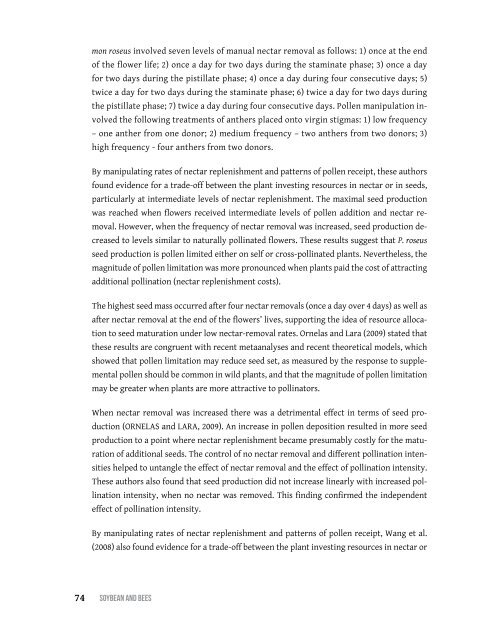Soybean and Bees
You also want an ePaper? Increase the reach of your titles
YUMPU automatically turns print PDFs into web optimized ePapers that Google loves.
mon roseus involved seven levels of manual nectar removal as follows: 1) once at the end<br />
of the flower life; 2) once a day for two days during the staminate phase; 3) once a day<br />
for two days during the pistillate phase; 4) once a day during four consecutive days; 5)<br />
twice a day for two days during the staminate phase; 6) twice a day for two days during<br />
the pistillate phase; 7) twice a day during four consecutive days. Pollen manipulation involved<br />
the following treatments of anthers placed onto virgin stigmas: 1) low frequency<br />
– one anther from one donor; 2) medium frequency – two anthers from two donors; 3)<br />
high frequency - four anthers from two donors.<br />
By manipulating rates of nectar replenishment <strong>and</strong> patterns of pollen receipt, these authors<br />
found evidence for a trade-off between the plant investing resources in nectar or in seeds,<br />
particularly at intermediate levels of nectar replenishment. The maximal seed production<br />
was reached when flowers received intermediate levels of pollen addition <strong>and</strong> nectar removal.<br />
However, when the frequency of nectar removal was increased, seed production decreased<br />
to levels similar to naturally pollinated flowers. These results suggest that P. roseus<br />
seed production is pollen limited either on self or cross-pollinated plants. Nevertheless, the<br />
magnitude of pollen limitation was more pronounced when plants paid the cost of attracting<br />
additional pollination (nectar replenishment costs).<br />
The highest seed mass occurred after four nectar removals (once a day over 4 days) as well as<br />
after nectar removal at the end of the flowers’ lives, supporting the idea of resource allocation<br />
to seed maturation under low nectar-removal rates. Ornelas <strong>and</strong> Lara (2009) stated that<br />
these results are congruent with recent metaanalyses <strong>and</strong> recent theoretical models, which<br />
showed that pollen limitation may reduce seed set, as measured by the response to supplemental<br />
pollen should be common in wild plants, <strong>and</strong> that the magnitude of pollen limitation<br />
may be greater when plants are more attractive to pollinators.<br />
When nectar removal was increased there was a detrimental effect in terms of seed production<br />
(Ornelas <strong>and</strong> Lara, 2009). An increase in pollen deposition resulted in more seed<br />
production to a point where nectar replenishment became presumably costly for the maturation<br />
of additional seeds. The control of no nectar removal <strong>and</strong> different pollination intensities<br />
helped to untangle the effect of nectar removal <strong>and</strong> the effect of pollination intensity.<br />
These authors also found that seed production did not increase linearly with increased pollination<br />
intensity, when no nectar was removed. This finding confirmed the independent<br />
effect of pollination intensity.<br />
By manipulating rates of nectar replenishment <strong>and</strong> patterns of pollen receipt, Wang et al.<br />
(2008) also found evidence for a trade-off between the plant investing resources in nectar or<br />
74 SoybeAn <strong>and</strong> bees


